Korean sword
The history of the sword (Korean geom 검; 劍) in the Korean Peninsula begins with imports via Bronze Age China in the mid 1st millennium BCE. Native production of Bronze and Iron swords appears to pick up beginning in the mid 1st millennium CE. Sword designs continue to be influenced by Chinese and Mongol contacts.[1]
Korea had its separate sword industry and a native tradition of Korean swordsmanship during the Joseon Dynasty (15th to 19th centuries). This tradition was eclipsed by the Japanese occupation of Korea (1910-1945). Since the later 20th century, there have been efforts towards reviving the lost arts of Korean sword-making and swordsmanhip.
Elements of the Korean sword include: geomjip or scabbard, most often of lacquer; hyuljo or fuller (most genuine Korean swords didn't have a fuller); hwando magi or collar; ho in or collar; kodeungi or hand guard; a ring-design pommel; tassels; a round and wide designed sword guard, or a straight lotus design.[2]
History
Early swords
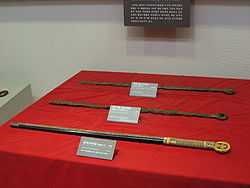
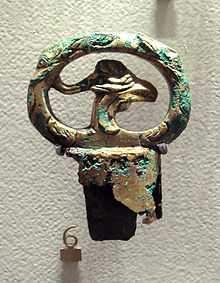
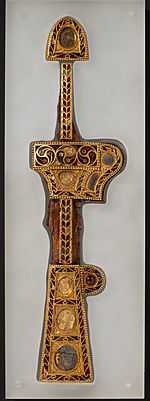
There is evidence of early imports of Chinese Bronze Age swords to the Korean peninsula. Evidence of sword production dates to the transitional Late Bronze to Early Iron Age (c. 1st century BC), with an earthenware mold for a Bronze Sword found in South Gyeongsang Province.[3]
The earliest Korean sword type is the so-called Hwandudaedo or "ring-pommel sword", prevalent during the 1st to 6th centuries. Until the 3rd century, these sword were very rare and presumably reserved for royalty. They became more attainable in the later 4th and during the 5th century, and are found in many higher class tombs of this period. Their production declined in the 6th century.
By the last third of the Three Kingdoms period (i.e. 450 AD and beyond), steel making techniques had come from China (possibly during the Southern and Northern Dynasties period in China) and were also employed in Korean swordmaking by all three Korean kingdoms (Goguryeo, Baekje, and Silla). In 2013, a Chinese inscription was discovered on a 5th-century sword from the Geumgwanchong tomb in Gyeongju, North Gyeongsang Province. The scabbard of the sword has the inscription 尒斯智王 Yisaji-wang ("King Isaji").[4]
Long swords during the Korean Three Kingdoms period were used primarily by cavalry and commanders (who were also usually mounted), not infantry. At this time land warfare consisted mostly of spearmen and bowmen on foot, mounted archers on horseback using two-handed bows, and mounted swordsmen with twin blades. Swords were not a primary weapon for all combat but were instead used mostly for shock attacks, defensive strokes, and for close-in fighting. Blades were heavy as they were made mostly of bronze and later iron, and pommels were often knobbed and used as balances or for very close-in work. Short swords may have been used in follow-up attacks, as short sword carriers were armoured completely.
Records indicate that the art of sword manufacturing, still in a rudimentary state, may have been transmitted to the Japanese Archipelago from the Korean Peninsula some time in the Three Kingdoms period, along with iron smelting and manufacture and later that of steel work; these methods and techniques, as well as their updates, continued to be transmitted during the North South States Period to the Japanese Archipelago until connections with the Asian mainland were largely closed off by Japan in the early part of the Heian period (794 AD to 1195 AD; the early part is considered to have ended in 967 AD).
During the Goryeo dynasty, a limited number of Korean swords were exported for trade missions in Asia. It is likely that Korean swordmaking was influenced by the various influences present in Mongol and Chinese weapon manufacture after Goryeo's submission as a Mongol vassal after 6 Mongol invasions ending in 1259.
Joseon period
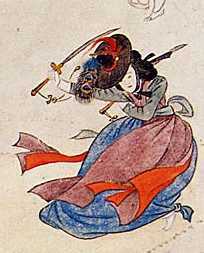
The Joseon period (15th to 19th centuries) is the "classical" era of Korean culture, including the creation of a national script and the suppression of Korean Buddhism in favour of Neo-Confucianism. Korean swords were in production both for military and ceremonial use. Several types of ceremonial swords were made; among these sword types are the jingeom (dragon sword) and ingeom (tiger sword), which by tradition could be forged only at certain times. The highest grade of these, sa-ingeom (four tigers sword) and possibly the sa-jingeom (four dragons sword - none are extant) were reserved for the monarch and could only be made during a window of 2 hours every 12 years. The lower-grade swords - i-jingeom, sam-jingeom, i-ingeom, sam-ingeom (two dragons, three dragons, two tigers, three tigers) - could be made more frequently.
The swords that Joseon soldiers used were crafted with the greatest care, using only high quality steel considered for the use of military swords. Some of the swords that were used uniformly by these soldiers include the jedok geom and bonguk geom. The three types of blades listed here are single edged and usually between 3–4 feet long, although the jedok geom could reach a length of 6 feet.
It was not uncommon for non-military sword carriers to import swords, frequently from Japan's renowned swordsmiths, in the event that Korean sources could not be secured (as they were frequently dedicated to the production of weapons for military use).
The saingeom is a type of Joseon-era sword from Western Korea fairly common in the Ai-Ching province. It has a 90 centimeter (35 inch) blade, produced primarily by molding rather than hammering.
Modern history
Korean swords are very scarce today, since most surviving examples were confiscated and destroyed during the colonial period. A systematic attempt was made to collect and destroy all Korean swords, coats of armour, and all Korean martial arts equipment. The entire history of Korean swords and armour was almost lost forever, along with much of Korea's culture and traditions, because of Japanese colonial policies.[5][6]
After the liberation of Korea in 1945, ceremonial swords were once again manufactured both in southern and northern Korea, and by the 1960s, sword-making was a vibrant and increasingly secure industry; however, due to the depredations and systematic destruction by the Japanese during the Japanese occupation of Korea, many traditions and techniques lost and were either completely unrecoverable or had yet to be recovered.
Types
Elements of the Korean sword include: geomjip or scabbard, most often of lacquer; hyuljo or fuller (most genuine Korean swords didn't have a fuller); hwando magi or collar; ho in or collar; kodeungi or hand guard; a ring-design pommel; tassels; a round and wide designed sword guard, or a straight lotus design.[2]
Geom (검 from Chinese 劍 jian) is the Korean word for "sword"; it is typically used of double edged swords, but is also applied to single edged swords. Yedo (예도; 銳刀) is the specific term for a single-edged sword. The Muyesinbo describes as bonguk geom or "national sword" a double-edged sword closely resembling the Eastern Han period jian. This contrasted with the jedok geom or "admiral sword", the term for the type introduced in the 16th century by Li Rusong, usually about 5–6 feet tall and single edged. The sword was also straight and wielded with one or two hands.
The Hwandudaedo (환두대도; 環頭大刀) or "ring-pommel sword) is a type of single edged sword used during the three kingdoms area. It is known for having a ring pommel and being single or double edged. Most swords during this time was semi-uniform in nature and many martial arts practitioners tend to recognize this weapon as a "Genuine Korean Sword". The Hwandudaedo may have some connection to the Japanese straight swords (tsurugi) and the Chinese Jian.
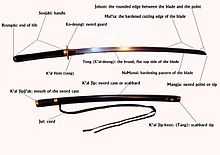
In deference to the Neo-Confucian state philosophy during the Joseon period, Korean swords tended to be somewhat shorter than their Japanese or Chinese templates, with a blunted tip and infrequently having a groove the length of the blade. In this way the sword was made to be represented as being as singularly "unaggressive" as possible.
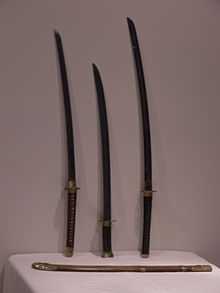
- Geom is the generic term for "sword", but more specifically also refers to a shorter straight-blade, double-edged sword with a somewhat blunted tip distinguishes this weapon from its Chinese counterpart, the jian. As a badge of status rather than a weapon, the Geom was often heavily decorated both on its sheath and grip as well as with engravings and inscriptions on its blade.[7]
- The To, commonly referred to as a Hwando or "military sword", was a single-handed, single-edged sword, in use as the stated sidearm of the Korean soldier well into the 19th century. Sometimes referred to as a "short sword", relative to the out sized two-handed Sangsoodo, its length of 24 to 34 inches was comparable to that of the two-handed Japanese Katana which may have been the inspiration for the Ssangsoodo. Reports found in the "Book of Corrections", a Korean record of the Imjin Warum (1592–1598) state that Japanese swords taken in combat were readily pressed into service by simply trimming the length of the sword grip (Tsuka). Forged of carbon steel the Korean To has a single edged, curved blade, a sword guard and a grip, typically of wood. Earlier practice saw the To carried by the Military, suspended from a cord (Jul) and with a simple metal hanger which allowed the soldier to speedily discard his sheath. In later practice, the sword was suspended from a girdle or belt but retained a simple metal quick-release clip.[7]
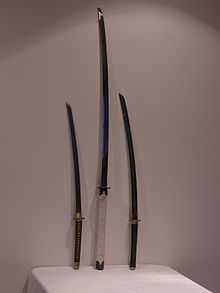
- The Ssangsudo (쌍수도; 雙手刀) is a double-handed single-edged sword in use only during a limited time, n the late 16th and early 17th centuries. Chinese literature and history both ascribe its adoption as a weapon on the Asian mainland to General QI Ji-guang (1628–1687) who is said to have taken pirate prisoners -Wokou- during his campaigns in Southern China, wrote about the sword in his manual - Lian Bing Shi Ji - and recommended its use as part of the defense along China's northern border. Since General Qi's training manual Jin Xiao Shin Shu was used in the revamping the Korean Military it followed that this weapon came highly recommended. Nor did the Koreans overlook that over sized swords had been used by Japanese soldiers during the recent conflict as well as during their own experiences with the Wakou. Intended by General Qi to be carried into combat on wagons or by individuals who drew each other's weapon, the Ssangsoodo measured an overall length of 6 feet, two feet of which were to be the grip and another 2 feet forward of the handle to be sheathed in brass or copper. Undoubtedly the length and weight of the sword, and the high level of training necessary to wield it, made the sword impractical as a common part of the Korean arsenal. It is also useful to note that the Ming Dynasty, which saw this weapon added to its own military, fell to the Manchu invaders some 50 years later.[8]
- The Hyup Do or "spear sword") is found in Book Three, Chapter seven. Though commonly taken for a polearm after the fashion of the Japanese Naginata, the text of the Muye Dobo Tong Ji relates that "the handle is about four feet....weighs about four pounds.....the illustration in this book is corrected according to the Mubiji and the Japanese Jang Do. They are the same." It is reasonable to conclude that the Hyup Do was much closer to the Japanese Nagimaki.[9]

- The *Woldo (월도; 月刀) was a bladed polearm, like its Chinese counterpart the Yaoyindao commonly decorated with a tassel or feather affixed to a prominence on the spine of the bladewhich assisted the person wielding the weapon with identifying the blades' center of mass. "the length of the handle is six feet, four inches; the length of the blade is two feet eight inches. The weight is about three pounds, fifteen ounces".[10]
- Ssangdo or Ssanggeom (쌍도; 雙刀; 쌍검: 雙劍) This literally means "Twin Swords." It can vary from twin long swords or twin short swords. These techniques can also be used on Horseback as 'Masang ssanggeom'. The Korean cavalry was famous for using Twin Sword techniques on horseback, while balancing on the horse with grace. Ssangyunggeom are two twin swords that is held with one sheath. The sheath is twice as wide because it needs room for the second sword. The sword's length varies from three to four feet. Usually these swords were double edged and made entirely of Iron (including the sheath).
- Hyeopdo (협도; 俠刀) This is also a large crescent blade that is similar to the 'Pudao' but wider and thicker. A tassle attached to the end of the blade.
- Janggeom (장검; 長劍): Literally means "long Sword".
- Hwando (환도): This is a single edged short sword that was strictly used with one hand. This was a common side arm for many soldiers during the Joseon era.
- Unggeom (웅검): This is a single edged long sword that was used with one or two hands. This was another common side arm for many soldiers during the Joseon era.
- Samgakdo (삼각도; 三角刀) The samgakdo, is also a recently used terminology for swords used for mat cutting. The cross section of the sword is triangular in shape; hence the name Samgakdo (which means 3 sided sword).
- For martial arts students learning sword forms or Geombeop/Geomsul practice wood swords or mokgeom are most often used; then those made out of carbonized bamboo or Juk-do; lastly compression sponge, single or double-edged, with or without blood grooves. Combinations of sword and knife fighting would use plastic blades.
- Chilseonggeom (칠성검; 七星劍) This sword is a single edged or double sword that Buddhist practitioners used. Many of these swords had constellation engravings on the blades (usually the Big Dipper).
- Sainchamsageom: This sword's name literally means 'Great Four Tiger Sword'. This is a ceremonial sword that is used for demon slaying and Shamanistic rituals.[11] The In Geom (Tiger Swords) were usually of the same designs but of different strengths. They were all made according to the Year, Month, Week, Day, or Hour of the Tiger.[11] C.f. Samingeom: 'Three Tiger Sword', I-ingeom 'Two Tiger Sword'.
- Samjeongdo (삼정도; 三正刀) the sword given to newly promoted Korean military generals each year by the Ministry of National Defense.
The Seven-Branched Sword is a peculiar specimen forged in Baekjae in the order of the king. There is a theory that this is a sword that was to be a gift presented to the emperor of Japan. There was no handle found for the blade nor was there a swordsheath found for it while it was being excavated.
Korean swordsmanship
During the Joseon period, swords also had ranks depending on who wielded them and what their purpose was. The highest ranking of these swords was known as the Byeol-ungeom (별운검: 別雲劍), literally meaning "cloud-splitting sword." Only two such swords existed and were wielded by the King's two bodyguards, who always stood on either side of him and held the nobility title of Un'geom (운검: 雲劍).
Master swordsmen
- General Kim Yushin, was said to have been given an engraved sword and sacred books by the gods, and helped to unify Korea under Silla. His most famous son, Kim Wonsul, was a noted swordsman who fought against the Tang Dynasty armies in the late Three Kingdoms period.
- Baek Dong Soo was a swordsman and martial artist who became a folk hero when his group protected King Jeongjo from assassination attempts. His most notable work, Muyedobotongji (illustrated manual of Korean martial arts).
Contemporary swords
Only by the mid-1990s did Korean swordmaking come back to expert levels comparable to the Joseon era. Haedong jingeom (해동진검; 海東劍) This literally means 'East Asian Practical Sword' is the neologistic term for current-day swords for "revivals" of Korean swordsmanship.
Sword ownership in Korea is currently restricted (private weapons ownership was culturally frowned upon and largely restricted during other times in Korean history, particularly during the Joseon era and the Japanese occupation period - albeit for different reasons in either period), and there are very few traditional sword collectors in Korea today. General/flag-grade officers are given dress swords upon assuming command in the Republic of Korea (ROK) army. Despite restrictions on sword ownership and a lingering social preference against armed martial arts (dating at least to the Joseon era), practical sword fighting is enjoying a small revival amongst elite military regiments, and fencing is once again attracting interest in Korean universities.
Sword producers
- Hong Seok-hyeon in Paju, Gyeonggi province, makes swords by hand.[12]
- Lee Sang Seon in Munkyong City, Kyongsangbukdo Province
- Lee Eun-cheul in Yeoju, Kyonggi Province
- Kang Cheul Kyu in Pocheon, Kyongki Province
In Korean popular culture
Korean historical action films have elements of swordsmanship within them. Important recent films readily available (and subtitle in Chinese/English) include:
- Musa The Warrior, 2001, 130 minutes, joint Korean/Chinese production
Chung Doo-Hong martial arts director. Set in the Goryeo dynasty, during 1375 chronicles General Choi Jung's mission to the Ming to make peace during their wars against the Yuan.
- Sword in the Moon, 2003
A Korean production that is a variant of Taegukgi: The Brotherhood of War. This is set in the Three Kingdoms of Korea period where there were various uprisings in the military and many assassination attempts on the King.
- Shadowless Sword, 2005
- Duelist, 2005
- Blades of Blood, 2010
See also
References
- ↑ Boots, John L. (1934). "Korean Weapons & Armor". Transactions of the Korea Branch of the Royal Asiatic Society (Royal Asiatic Society Korea Branch). 23 Part 2: 1–37. (Full text of Microsoft Word format is available here)
- ↑ 2.0 2.1 한국환상사전. 무기와 방어구 편
- ↑ Korean National Museum Accession Number Bongwan 14050
- ↑ Sword sparks debate, The Korean Times, 4 July 2013. Discovery of the Silla Geumgwanchong Tomb "King Isaji" Sword Inscription (museum.go.kr) 3 July 2013.
- ↑ Hong Wontack 1994 Paekchae of Korea and the origin of Yamato Japan, Seoul Kadura International
- ↑ Coval, Dr John Carter and Alan, 1984, "Korean impact on Japanese culture: Japan's hidden History" Hollym International Corp., Elizabeth, New Jersey
- ↑ 7.0 7.1 Comprehensive Illustrated Manual of Martial Arts; YI Duk-moo1 & PARK Je-ga (1795); Trans: KIM Sang H; Turtle Press, 2000; Book 2, Chap 2 pg 141
- ↑ Comprehensive Illustrated Manual of Martial Arts; YI Duk-moo1 & PARK Je-ga (1795); Trans: KIM Sang H; Turtle Press, 2000; Book 2, Chap 1, pg 129
- ↑ Comprehensive Illustrated Manual of Martial Arts; YI Duk-moo1 & PARK Je-ga (1795); Trans: KIM Sang H; Turtle Press, 2000; Book 3, Chap 7, pg 283
- ↑ Comprehensive Illustrated Manual of Martial Arts; YI Duk-moo1 & PARK Je-ga (1795); Trans: KIM Sang H; Turtle Press, 2000; Book 3, Chap 5, pg260
- ↑ 11.0 11.1 Ancient Art of Korea. Swords in Chosun Kingdom
- ↑ JoongAng Daily. Keeping an ancient craft alive
External links
| Wikimedia Commons has media related to Swords of Korea. |
- Swords of Korea
- 한국의 칼
- Stone Swords (click on 유물보기 for pictures)
- Bronze Swords (click on 유물보기 for pictures)
- Swords with Ring Pommel (click on 유물보기 for pictures)
- Joseon Period Swords (click on 유물보기 for pictures)
- 전통도검
- Ancient Swords of Korea
- 한국의 칼 특별전 (includes a video of Korean swords)